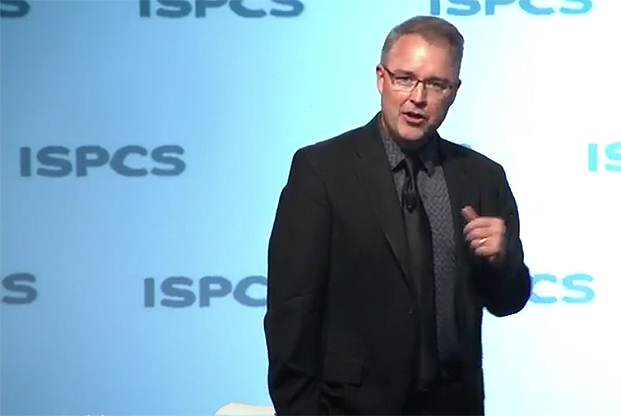
Fred G. Kennedy, shown here at ISPCS 2017, was named the first director of the Space Development Agency. Kennedy currently serves as the director of DARPA's tactical technology office. Screenshot from ISPCS YouTube video.
Acting Defense Secretary Pat Shanahan on Tuesday signed a memo establishing a Space Development Agency as the new face of Pentagon-wide space research and engineering.
A key but somewhat controversial piece of the Defense Department’s attempt to reorganize its space enterprise, the SDA will pull engineers and other personnel from military laboratories and the national and international science communities to develop the next generation of space systems and networks.
“A national security space architecture needed to deter or, if deterrence fails, defeat adversary action is a prerequisite to maintaining our long-term competitive advantage,” Shanahan wrote in the March 12 memo obtained by Air Force Magazine. “We cannot achieve these goals, and we cannot match the pace our adversaries are setting, if we remain bound by legacy methods and culture.”
DOD tapped Fred Kennedy, director of DARPA’s tactical technology office, as the SDA’s first director, according to the memo. Military personnel and civilians will work for SDA, but the Defense Department has not named a uniformed counterpart for Kennedy—if he is to have one at all.
Kennedy will lead efforts to “define and monitor” the Pentagon’s space architecture and speed the time it takes to field new capabilities, similar to the Air Force’s Space Rapid Capabilities Office. The Senate does not need to confirm his appointment.
“The SDA will unify and integrate the development of space capabilities, except those funded in the [Military Intelligence Program], across the department to achieve the DOD space vision and reduce overlap and inefficiency,” according to the memo.
SDA’s first priority is the “design, architecture, orchestration, development of a highly proliferated low-earth orbit sensor and communications transport layer” to defend against hypersonic weapons, ensure communications systems can connect in an emergency, and boost global situational awareness, Pentagon research and engineering chief Mike Griffin said at a roundtable with reporters Wednesday.
That architecture would combine both military-grade and commercial products, he said. He declined to say what experiments and prototyping efforts may be in the works in case plans change.
The LEO layer idea will draw on lessons learned from Blackjack, a classified DARPA initiative that aims to field a mass-produced, resilient network of commercial satellites equipped with military sensors in low-earth orbit.
“Blackjack is a critical early experiment in this arena,” Griffin said, although he doesn’t view it as a proof of concept. “In the Space Development Agency, we’re going to be trying to develop an objective system with very important peacetime uses. … It has to work. DARPA does experiments, not all of which have to work.”
Griffin dismissed the idea that SDA would duplicate work managed by DARPA, the Air Force’s Space and Missile Systems Center, its Space Rapid Capabilities Office, or other groups.
Organizations like SMC “have a very important function with continuing to produce and oversee the legacy space architecture, the things we have in space today that we surely don’t want to give up,” Griffin argued. Pursuing a new architectural paradigm requires a new DOD agency, he said.
“I don’t really see any reasonable possibility that the two functions of the two different agencies will get crossed up,” Griffin said. “DARPA does early stuff and transitions to operational partners, and Space Development Agency is starting out to … architect an operational system.”
In building the sensor and communications layer, Griffin hopes to work with non-defense agencies like the National Reconnaissance Office to cultivate a broad set of varied capabilities. He also wants to cast a wide net in commercial industry to avoid getting stuck with just a few companies.
SDA received about $150 million in the Pentagon’s fiscal 2020 budget request, which began rolling out this week. Griffin declined to answer funding questions because budget details are not yet public.
Shanahan’s memo says fiscal 2019 and 2020 funds need to be reprogrammed as well, but does not provide specific dollar amounts. A Defense Department spokeswoman declined to provide the amounts.
But SDA may not be a standalone organization for long, according to Shanahan’s memo, which states DOD is “committed” to moving the agency to the Space Force when Congress approves the new service.
“Coordination of requirements and transition decisions will occur through the normal processes once SDA transfers to the US Space Force,” Shanahan wrote. “Until that time, the department will evaluate additional consolidation of space development organization and management.”
Griffin acknowledged key voices within the Pentagon aired their disagreements as they hashed out whether and how to stand up SDA.
Air Force Secretary Heather Wilson, who until her resignation announcement last week was expected to oversee the Space Force as a sixth service within her own department, questioned whether it makes sense to create a group that could exist on its own for less than a year before it would join the Space Force.
“I have some concerns about what is the mission of this entity. Why do we think it would be better than what we currently do, and what exactly would it focus on,” she said during a roundtable at AFA’s Air Warfare Symposium last month. “Some of the programs that have initially been floated as concepts to pursue are currently done by DARPA, and funded partly by the Air Force. … We’re quite satisfied with the work that DARPA’s doing.”
Griffin told reporters it won’t matter much if the Space Force is ultimately established or not because the development agency can exist on its own.
“The Air Force has broadly disapproved of Secretary Shanahan’s decision. Everybody can’t always agree,” he said, before listing historical examples of institutional resistance to change.
Without singling out one group, Griffin said: “It is a general rule that large, existing organizations do not respond well or favorably toward new innovations. It would be an exception if they did embrace a new idea.”